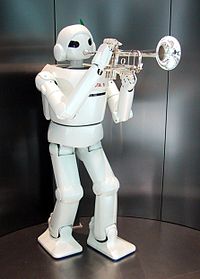
Photo from wikipedia
Otosclerosis surgery is performed through a transcanal approach and requires long, thin instruments with submillimetric precision and precise amplitude of motion. The functional outcomes and complications of otosclerosis surgery depend… Click to show full abstract
Otosclerosis surgery is performed through a transcanal approach and requires long, thin instruments with submillimetric precision and precise amplitude of motion. The functional outcomes and complications of otosclerosis surgery depend on the experience of the surgeon. Thus, any technological assistance that can enhance the surgeon's dexterity and rapidly reduce the learning curve could yield an even safer surgical procedure. One of the options is to use robotic assistance to achieve this goal. An overview of different robots designed for otosclerosis surgery is presented focusing on the RobOtol system that we have designed as a multitask platform for ear surgery.
Journal Title: Otolaryngologic clinics of North America
Year Published: 2018
Link to full text (if available)
Share on Social Media: Sign Up to like & get
recommendations!